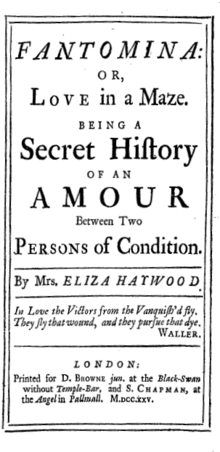Amatory fiction

Amatory fiction is a genre of British literature popular during the late 17th century and 18th century. Amatory fiction predates, and in some ways predicts, the invention of the novel. Amatory fiction was written by women and considered to be mainly read by women. Considering, however, the popularity of the genre it is highly likely that men read these novels just as well. As its name implies, amatory fiction is preoccupied with sexual love and romance. It is an early predecessor of the romance novel. Indeed, many themes of the contemporary romance novel were first explored in amatory fiction.
The three most prominent amatory fiction writers were Eliza Haywood (who wrote Love in Excess; Or, The Fatal Enquiry), Delarivier Manley, and Aphra Behn. Together, these writers were known as the "fair triumvirate," though their reputation for scandalous writing caused some to call them the "naughty triumvirate."[1]
Themes of amatory fiction
Narrowly defined, amatory fiction is a formulaic genre which typically depicts an innocent, trusting woman who is deceived by a self-serving, lustful man. For the women of amatory fiction, love typically ends in misery.
Although amatory fiction has traditionally been excluded from "rise of the novel" narratives, recent scholarship concludes that these works are not merely precursors to the novel, but novels in their own right.
Authors of amatory fictions often detailed extramarital affairs, which conveniently allowed them to avoid the complications of property, which was a strong motivation for marriage when amatory fiction was popular.
Some works of amatory fiction were considered amoral by contemporary standards, and allowed their characters to commit scandalous love affairs without being "punished" based on themes of Christian, social, legal or other forms of poetic justice.
Notes
- ↑ Toni O'Shaughnessy Bowers, "Sex, Lies, and Invisibility: Amatory Fiction from the Restoration to Mid-Century," The Columbia History of the British Novel, Ed. John Richetti, Columbia UP, 1994, 51.